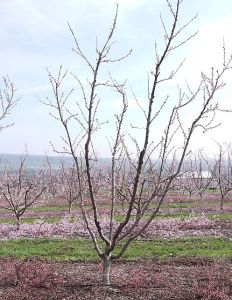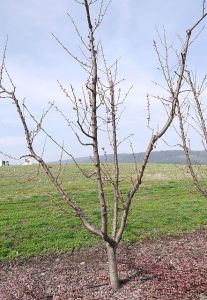Peach Training Systems Aren’t One-Size-Fits-All

Hex-V Training System
(Photo credit: Photo credit: Edwin Winzeler, Penn State University)
Peach training systems are not a one-size-fits-all proposition says Bill Shane senior Michigan State University (MSU) Extension tree fruit specialist. In fact, there are a lot of considerations to keep in mind when selecting the proper training system for your orchard.
“I don’t think we’ve settled upon the perfect system yet. There’s considerations on the climate, and varieties and whether you want to use a large tractor-mounted string thinner, handlheld thinner, or non-mechanical methods to reduce fruit load,” he says.
Labor costs are also a factor. Growers need to be considering newer systems that can help save on labor and maintenance costs throughout the growing season.
“Labor costs are a major issue in fresh stone fruit production with hand pruning, hand fruit thinning, and hand harvest. Some peach growers are looking at new pruning/training systems combined with size-controlling rootstocks to lower tree height, and this can lead to lower labor costs,” says Ted DeJong, a University of California (UC) Cooperative Extension specialist.
To offset some of these labor costs with thinning and harvesting, growers are considering moving to a laderless orchard, by using dwarfing or semi-dwarfing rootstocks.
Sticking With The Tried And True
New training methods aren’t the only way to deal with ladder issues, of course. Lots of growers opt to stay with traditional production systems such as open center or open vase systems. Trees in the open vase system have shorter height for labor access.
Jim Schupp, associate professor of pomology at Penn State’s Fruit Research and Extension Center, says growers in his region have planted open center, or open vase trees, for so long that they “are familiar to the sins of open vase and become blind to them.”
Open vase, with its cylindrical shape, is a problem for future mechanization, Schupp says. Growers must hand thin trees, which adds to labor costs. Another challenge with an open center system is reduced yield and fruit color because of low light interception and penetration.

Quad-V Training System
(Photo credit: Edwin Winzeler, Penn State University)
Potential For Other Systems
DeJong says that although growers may prefer to stay with a traditional production system to minimize risk and cost of changing, this may not be feasible in the future as labor and resources become scarce.
“It is questionable whether this strategy will be sustainable as pressures increase from all sides, including labor costs and availability, environmental regulations, resource limitations, and market demands,” he says.
Schupp advocates for taller trees in V growing systems. However, trees are taller, which makes for a more labor-intensive crop.
“Growers often want short trees as opposed to tall perpendicular V,” Schupp says. “Bite the bullet, grow them tall.”
A common challenge with the perpendicular V system, Schupp says, is the bearing surface of trees migrates up. Renewal pruning is not as successful as well.
However, all V systems provide greater yield and fruit color as a result of higher light interception and penetration. Mechanization is also easier with the V systems.
Penn State Training System Trial
Schupp and Tara Baugher, co-team leader of the Penn State tree fruit Extension program, conducted a peach orchard systems trial. Trees were grown in a perpendicular V at 5-foot row spacing, quad V at 7-foot row spacing, hex V at 10-foot row spacing and open center at 14-foot row spacing.
“While all three V systems in our study produced more small-sized fruit than the open center trees, the quad-V and hex-V also produced more 2.75-inch and 3-inch fruit than the open-center trees,” Baugher says.
Schupp and Baugher say cultural practices such as pruning to appropriate crop load, blossom thinning, green fruit hand thinning as well as trickle irrigation during the final fruit swell help trees in any system perform at their greatest potential.
“A change in our peach orchard training systems is long overdue. Quad-V is a productive and easy-to-train tree wall system that facilitates mechanization for labor efficiency,” Schupp says.

A mechanical string thinner reduces crop load at bloom on trees in a perpendicular-V training system. (Photo credit: Edwin Winzeler, Penn State University)
Reducing Tree Height
One way growers in California are creating more efficient orchards is to transition from 13- or 14-foot trees to more pedestrian orchards in the 9- to 10-foot range. Less reliance on ladders can create a more efficient use of time in the orchard.
“When you’re climbing up and down a ladder you’re not pruning, thinning, or picking. You’re moving ladders,” says Kevin Day, a UC Cooperative Extension farm advisor for Tulare County says.
Day says growers often assume a larger tree bears more large fruit. So, he encounters some resistance to planting trees in the 7-foot range. When a tree intercepts 70% to 80% of sunshine, the tree can be taller, but the light interception efficiency does not increase.
“We’ll show them an early season variety where the industry average is 400 boxes per acre and we can do 450 or 500 on a short tree. Growers say, ‘wait a minute, if they can get 500, maybe I can get 700.’ But, it doesn’t work that way because an acre of light is an acre of light,” he says.
Can Peaches Grow Like Apples?
Most peach researchers are skeptical that high-density orchards are feasible for peaches. The trees are simply too different in fruit-bearing habits to make an assumption that tall spindle systems would work.
“It is questionable whether the super-high-density systems being promoted for apples will ever make sense for peach because of tree growth and fruit bearing habits,” DeJong says.
Full mechanization, DeJong says, will also be quite difficult for peach growers.
“Current fruit marketing pressures require high quality, blemish-free fruit that can only be obtained with rather precise hand pruning, fruit thinning and hand harvest, but there is a lot of room for improvement of current practices to reduce the high labor costs of these operations,” he says.
Dwarfing Rootstocks Coming
Although there are some dwarfing rootstocks available for peach growers, most are interspecific hybrids and can cause tree stress due to incompatibility. There is also some question in biological efficiency of some of these interspecific hybrids.
Penn State is studying some of these newer rootstocks, and some look promising for Eastern growers, Schupp says. Dwarfing rootstock for peach trees has been a missing component in the growing system equation, he says.
Some of these dwarfing and semi-dwarfing rootstocks with favorable results in Pennsylvania are Controller 8, KV 10123, and Guardian.
“There is reason for optimism that we may soon have the missing key,” he says.










